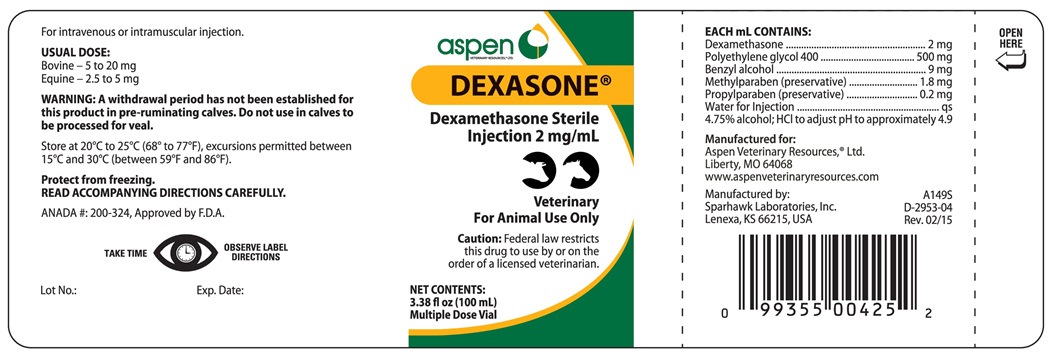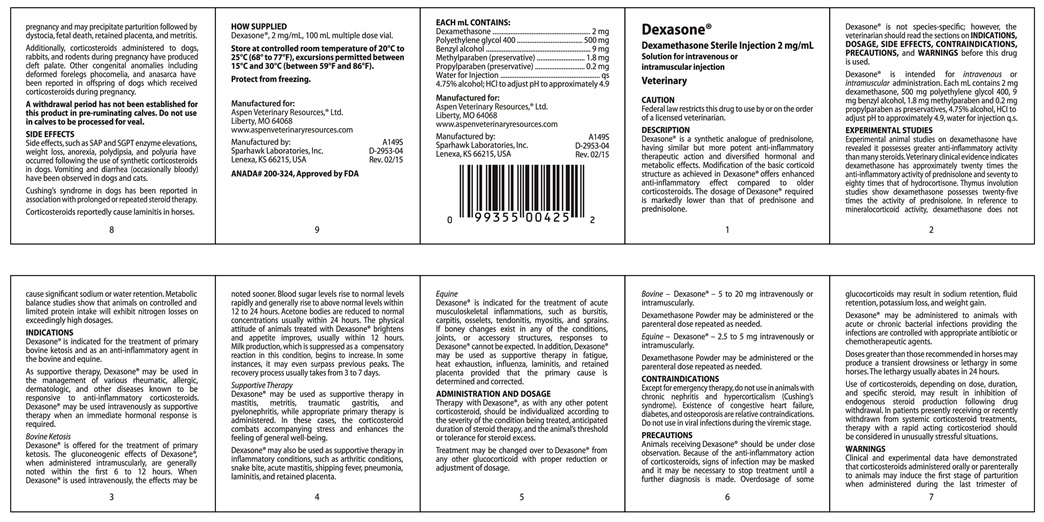DEXASONE- dexamethasone injection, solution
DEXASONE by
Drug Labeling and Warnings
DEXASONE by is a Animal medication manufactured, distributed, or labeled by Aspen Veterinary Resources, Ltd., Sparhawk Laboratories, Inc., Pharmacia & Upjohn Company LLC. Drug facts, warnings, and ingredients follow.
Drug Details [pdf]
-
DESCRIPTION
Dexamethasone Sterile Injection 2 mg/mL
ANADA #: 200-324, Approved by FDA
For Animal Use Only
Solution for intravenous or intramuscular injection
Veterinary
CAUTION: Federal Law restricts this drug to use by or on the order of a licensed veterinarian.
DESCRIPTION
Dexasone® is a synthetic analogue of prednisolone, having similar but more potent anti-inflammatory therapeutic action and diversified hormonal and metabolic effects. Modification of the basic corticoid structure as achieved in Dexasone® offers enhanced anti-inflammatory effect compared to older corticosteroids. The dosage of Dexasone® required is markedly lower than that of prednisone and prednisolone.Dexasone® is not species-specific; however, the veterinarian should read the sections on INDICATIONS, DOSAGE, SIDE EFFECTS, CONTRAINDICATIONS, PRECAUTIONS, and WARNINGS before this drug is used.
Dexasone® is intended for intravenous or intramuscular administration. Each mL contains 2 mg dexamethasone, 500 mg polyethylene glycol 400, 9 mg benzyl alcohol, 1.8 mg methylparaben and 0.2 mg propylparaben as preservatives, 4.75% alcohol, HCl to adjust pH to approximately 4.9, water for injection q.s.
-
EXPERIMENTAL STUDIES
Experimental animal studies on dexamethasone have revealed it possesses greater anti-inflammatory activity than many steroids. Veterinary clinical evidence indicates dexamethasone has approximately twenty times the anti-inflammatory activity of prednisolone and seventy to eighty times that of hydrocortisone. Thymus involution studies show dexamethasone possesses twenty-five times the activity of prednisolone. In reference to mineralocorticoid activity, dexamethasone does not cause significant sodium or water retention. Metabolic balance studies show that animals on controlled and limited protein intake will exhibit nitrogen losses on exceedingly high dosages.
-
INDICATIONS
Dexasone® is indicated for the treatment of primary bovine ketosis and as an anti-inflammatory agent in the bovine and equine.
As supportive therapy, Dexasone® may be used in the management of various rheumatic, allergic, dermatologic, and other diseases known to be responsive to anti-inflammatory corticosteroids. Dexasone® may be used intravenously as supportive therapy when an immediate hormonal response is required.
Bovine Ketosis Dexasone® is offered for the treatment of primary ketosis. The gluconeogenic effects of Dexasone®, when administered intramuscularly, are generally noted within the first 6 to 12 hours. When Dexasone® is used intravenously, the effects may be noted sooner. Blood sugar levels rise to normal levels rapidly and generally rise to above normal levels within 12 to 24 hours. Acetone bodies are reduced to normal concentrations usually within 24 hours. The physical attitude of animals treated with Dexasone® brightens and appetite improves, usually within 12 hours. Milk production, which is suppressed as a compensatory reaction in this condition, begins to increase. In some instances, it may even surpass previous peaks. The recovery process usually takes from 3 to 7 days.
Supportive Therapy Dexasone® may be used as supportive therapy in mastitis, metritis, traumatic gastritis, and pyelonephritis, while appropriate primary therapy is administered. In these cases, the corticosteroid combats accompanying stress and enhances the feeling of general well-being. Dexasone® may also be used as supportive therapy in inflammatory conditions, such as arthritic conditions, snake bite, acute mastitis, shipping fever, pneumonia, laminitis, and retained placenta.
Equine Dexasone® is indicated for the treatment of acute musculoskeletal inflammations, such as bursitis, carpitis, osselets, tendonitis, myositis, and sprains. If boney changes exist in any of the conditions, joints, or accessory structures, responses to Dexasone® cannot be expected. In addition, Dexasone® may be used as supportive therapy in fatigue, heat exhaustion, influenza, laminitis, and retained placenta provided that the primary cause is determined and corrected.
-
ADMINISTRATION AND DOSAGE
Therapy with Dexasone®, as with any other potent corticosteroid, should be individualized according to the severity of the condition being treated, anticipated duration of steroid therapy, and the animal's threshold or tolerance for steroid excess.
Treatment may be changed over to Dexasone® from any other glucocorticoid with proper reduction or adjustment of dosage.
Bovine - Dexasone® - 5 to 20 mg intravenously or intramuscularly.
Dexamethasone Powder may be administered or the parenteral dose repeated as needed.
Equine - Dexasone® - 2.5 to 5 mg intravenously or intramuscularly.
Dexamethasone Powder may be administered or the parenteral dose repeated as needed.
- CONTRAINDICATIONS
-
PRECAUTIONS
Animals receiving Dexasone® should be under close observation. Because of the anti-inflammatory action of corticosteroids, signs of infection may be masked and it may be necessary to stop treatment until a further diagnosis is made. Overdosage of some glucocorticoids may result in sodium retention, fluid retention, potassium loss, and weight gain.
Dexasone® may be administered to animals with acute or chronic bacterial infections providing the infections are controlled with appropriate antibiotic or chemotherapeutic agents.
Doses greater than those recommended in horses may produce a transient drowsiness or lethargy in some horses. The lethargy usually abates in 24 hours.
Use of corticosteroids, depending on dose, duration, and specific steroid, may result in inhibition of endogenous steroid production following drug withdrawal. In patients presently receiving or recently withdrawn from systemic corticosteroid treatments, therapy with a rapid acting corticosteroid should be considered in unusually stressful situations.
-
WARNINGS
Clinical and experimental data have demonstrated that corticosteroids administered orally or parenterally to animals may induce the first stage of parturition when administered during the last trimester of pregnancy and may precipitate parturition followed by dystocia, fetal death, retained placenta, and metritis.
Additionally, corticosteroids administered to dogs, rabbits, and rodents during pregnancy have produced cleft palate. Other congenital anomalies including deformed forelegs phocomelia, and anasarca have been reported in offspring of dogs which received corticosteroids during pregnancy.
A withdrawal period has not been established for this product in pre-ruminating calves. Do not use in calves to be processed for veal.
-
SIDE EFFECTS
Side effects, such as SAP and SGPT enzyme elevations, weight loss, anorexia, polydipsia, and polyuria have occurred following the use of synthetic corticosteroids in dogs. Vomiting and diarrhea (occasionally bloody) have been observed in dogs and cats.
Cushing's syndrome in dogs has been reported in association with prolonged or repeated steroid therapy.
Corticosteroids reportedly cause laminitis in horses.
- HOW SUPPLIED
-
COMPONENTS
Each mL contains:
Dexamethasone..........................2 mg
Polyethylene glycol 400...........500 mg
Benzyl alcohol............................9 mg
Methylparaben (preservative).....1.8 mg
Propylparaben (preservative)......0.2 mg
Water for Injection...........................qs
4.75% alcohol; HCl to adjust pH to approximately 4.9 - Usual Dose
-
WARNING
A withdrawal period has not been established for this product in pre-ruminating calves. Do not use in calves to be processed for veal.
Store at 20°C to 25°C (68° to 77°F), excursions permitted between 15°C and 30°C (between 59°F and 86°F).
Protect from freezing.
READ ACCOMPANYING DIRECTIONS CAREFULLY.
- PRINCIPAL DISPLAY PANEL
-
INGREDIENTS AND APPEARANCE
DEXASONE
dexamethasone injection, solutionProduct Information Product Type PRESCRIPTION ANIMAL DRUG Item Code (Source) NDC: 46066-223 Route of Administration INTRAMUSCULAR, INTRAVENOUS Active Ingredient/Active Moiety Ingredient Name Basis of Strength Strength DEXAMETHASONE (UNII: 7S5I7G3JQL) (DEXAMETHASONE - UNII:7S5I7G3JQL) DEXAMETHASONE 2 mg in 1 mL Packaging # Item Code Package Description Marketing Start Date Marketing End Date 1 NDC: 46066-223-04 100 mL in 1 VIAL, MULTI-DOSE Marketing Information Marketing Category Application Number or Monograph Citation Marketing Start Date Marketing End Date ANADA ANADA200324 02/21/2006 Labeler - Aspen Veterinary Resources, Ltd. (627265361)
Trademark Results [DEXASONE]
Mark Image Registration | Serial | Company Trademark Application Date |
|---|---|
 DEXASONE 78196897 2857871 Live/Registered |
ASPEN VETERINARY RESOURCES, LTD. 2002-12-20 |
 DEXASONE 72396966 0943956 Dead/Expired |
JOHN D. COPANOS & CO., INC. 1971-07-12 |
© 2026 FDA.report
This site is not affiliated with or endorsed by the FDA.

